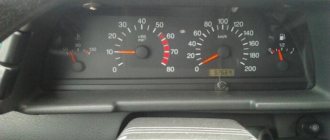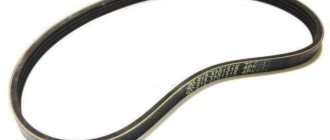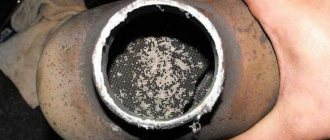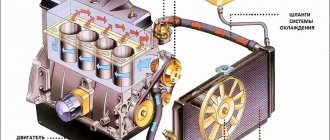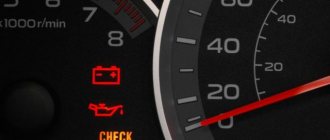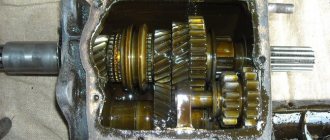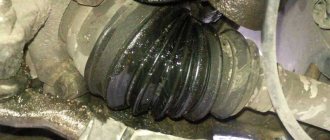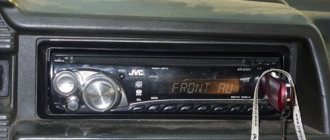Why does the radio tape recorder not read the flash drive?
A common reason why the radio does not read a flash drive is the file system of the storage device. Most older models are designed to work in the FAT 16 and FAT 32 systems. For modern standard devices, the flash drive format for the car radio is most often NTFS. For the USB media to be in a supported format, it must be formatted. To do this you will need a computer or laptop.
Which radio do you recommend buying?
The reason for the radio freezing or completely refusing to read information from digital media may be the volume of the latter. To solve this problem, it is recommended to study the technical specifications of the device. Another option is the selection method. A USB drive, for example, with a capacity of 8 GB, is installed in the car radio connector. If the connected device is not supported, the radio will not play sound. In this situation, take a flash drive whose memory size is smaller, for example, 4 GB, and try connecting again.
Some radios are designed to read only small volumes. For this reason, a flash drive with a size of 1 GB may be suitable.
Any device has a limited service life. Therefore, the cause of the malfunction may be a failure of the flash drive. To test this, you will need another device to play the recorded music. This can be done, for example, on a speaker (with a USB port).
If the device is working properly, has the appropriate file system, a suitable volume, works on other music installations, but you cannot listen to music in the car, the reason may be an incorrect recording.
Problems can also arise due to a malfunction of the reproducing equipment. This often happens when the radio has an Internet connection function. A car gadget may be infected with a virus, which will cause the device to malfunction.
Incorrect connection of the digital media is also one of the reasons that can become an obstacle to listening to songs in the car. In most cases, this problem occurs among car enthusiasts who have old equipment that does not have an appropriate input, i.e. The flash drive is connected via an adapter or other means.
The flash drive connector is faulty. This technical problem often occurs if the drive is removed incorrectly (torn out).
The flash drive itself is faulty
A common reason why the radio does not see the flash drive is an erroneous file system format or a computer failure that went unnoticed when formatting the drive. Some tape recorders are equipped with a diagnostic unit that displays an error code or text message. Some of the Pioneer radios have a USB port diagnostic unit with codes displayed on the display. The appearance of the text ERROR23 indicates the use of a drive with an incorrect file system.
Sometimes the device is recognized by the player, but the radio does not see the files or cannot play music content. For repairs, reformatting is carried out in a standard supported by the car radio. When using equipment manufactured before 2008, it is recommended to use the FAT16 standard. For products assembled after 2010, the FAT32 format is acceptable. The list of compatible standards is given in the operating instructions or selected empirically (if documents are lost).
There are floating defects that have no underlying cause. The same flash drive, which does not play in the car's radio, works in a neighboring car with an identical player. In this case, the vehicle owner will have to select a drive that is compatible with the installed head unit. If the external drive is not readable by radios and computers, then restoring the device is not economically feasible.
What format of flash drive is needed for the radio?
Format—drive file system. There are 3 main ones: FAT32, NTFS, EXT. The last 2 are not used for radios.
The FAT32 (File Allocation Table) format is understood as the standard version, which was created from the previous FAT16. Almost not supported due to being outdated.
FAT32 is a special table where files and information are located in a given sequence. This uses 32-bit cluster addressing. Now this system has been maximally improved.
FAT32 is a flash drive format for car radios, although it is the simplest. But complex data will not be stored on such a medium either.
Choice
Not only a special flash drive format is needed for the radio. This type of storage has become one of the most common. In addition to the file system on the flash drive, attention is paid to other criteria for choosing a device for a radio in a vehicle.
It is necessary to take into account the specifics of turning on the radio in the car. Since the USB connector may be located in the front, a large flash drive will break. The nest may also be damaged. Therefore, you need to choose a small option that will not stick out too much and interfere.
A small device should be well protected. The flash drive will work in any weather with temperature changes, vibration and other unfavorable factors.
Because of this, malfunctions in its operation may appear over time, so it is better to choose the most reliable option.
It is necessary to pay attention to the volume of the media. It is best not to choose a flash drive with too high an indicator, since the radio may not see the files. A good option is 4 GB. You can upload a large number of musical compositions there. Suitable for both old and new car radios. You can additionally check drives with larger capacities. If everything functions stably, then you can take this option.
Several options for good flash drives for car radios:
- Apacer Handy AH134. Looks like a car key. It is small in size, convenient in shape and waterproof. The body is solid. Models with a capacity of 4 and 8 GB are sold.
- HP V165W. The device can operate at air temperatures of +0…+60°C. There are volumes up to 32 GB.
- Kingstone Micro. The device has a special hole where you can thread a rope or keychain. The body is stamped from the inside. This option is less durable. It is suitable for those who do not plan to often remove the flash drive from the connector.
- PQI U280L Button Disk. The case has special hooking elements to make it easy to remove the device from the connector. But it is not necessary to remove the flash drive, since it can be left in the car overnight. This model can operate at temperatures ranging from -20...75°C.
- Pretec iDisk BulletProof. Manufacturers claim that the device can withstand even being shot with a bullet. The downside is its large dimensions, so it should be used carefully. The case itself is durable, but the socket can be damaged. Options with memory from 2 to 32 GB are sold.
How to format correctly
To correctly format a flash drive for a car radio, you need to insert it into a USB connector on a computer or laptop. Afterwards, you need to right-click on the icon of the device itself and select “properties” from the drop-down context menu. Next, a window appears where the format - the type of file system - is displayed under the name of the media.
If this format is not readable in the car, you need to format the flash drive for the radio:
- Right-click on the media.
- Select the “format” tab.
- Select FAT32 format.
- Click the “start” button.
After some time, the format will be converted to the required one. Then you can transfer all the data back to the media.
It must be remembered that after formatting the flash drive, all files on it will be deleted.
It is best to simply save the data on a computer or other storage device.
Sometimes the radio cannot work with the selected drive and displays an error. In this case, you need to format the flash drive so that the radio can read it.
How to record music
Before you record music onto a flash drive for your car radio, you need to take some preparatory steps.
The algorithm of actions is as follows:
- Determine the file system and select the correct one. Please note that the radio will support FAT32. If necessary, format the media.
- Select the correct file format for the recorded song from your computer. Almost all car radios have an MP3 option. If the files have a different extension, then you can either convert them or find a replacement composition, but with the required format. For the first option, the Format Factory program is suitable. You will need to drag the file into the work area, select the appropriate format in the window, and then click “OK”.
- Copy and record music to a flash drive for the radio. To do this, you need to insert the media into the appropriate slot. Then open the folder where the music is stored and copy it (right-click to select the “copy” function). Then open the drive itself and insert the files (right-click to select “insert” from the drop-down menu).
After this, all selected files will be located on the flash drive. It can be pulled out of the connector on the computer and connected to the radio.
How to make music scatter
If music tracks in a car are constantly played only in the same order, then you want variety.
There are several methods on how to arrange them so that they are included in the spread:
- Total Commander program. This is a file manager. Additionally, you need to install the special Random WDX plugin. It is intended specifically for mixing files. You need to run the program and select the folder on the flash drive where you want to mix the songs. Then you need to select the “Group Rename” function. In the window that opens, you need to create a “Renaming mask”.
- ReNamer program. It is designed to rename files. After installing it, you need to open “Add files” and select those that are needed. You can select the entire folder. Then, through the “Filters” function, a mask is selected for further renaming. Additionally, you need to select the “Randomization” item. All that remains is to click the “Rename” button.
- AutoRen. After installing such a program, you need to open the necessary folder with music. Then, in the “Symbols” section, perform a rename with the “Random” function.
- SufflEx1. This program rearranges files in a folder. You need to install it and click the “Shuffle” button.
All these programs rename files, so that later the songs will sound random when played on the radio.
The radio sees the flash drive but does not play
Sometimes the flash drive opens on the computer, but refuses to play in the car - let’s find out how to solve this problem...
If a flash drive plays on the computer, but not in the car, then this does not necessarily indicate a malfunction of the drive.
The problem may be either in the disk drive or in the radio itself. Most likely, the flash drive is simply formatted in a file system that the car radio does not support. Of course, there are other reasons why a flash drive does not play in a car, but works on a computer.
There are several main reasons why a flash drive does not play in a car but plays on a computer:
- The memory capacity of a flash drive is not supported by the car radio - as a rule, these are large-capacity flash drives. The car radio manufacturer always indicates the maximum disk storage capacity supported by the device. Thus, if the manufacturer warns that the radio only recognizes flash drives up to 4 GB, the radio will not read 8 GB flash drives.
- A car radio does not support the file system of a flash drive - old radios, for example, usually do not support drives formatted in the FAT32 file system, respectively, if the flash drive is formatted in NTFS, then the music will not play in the car.
Before solving the problem of why the flash drive does not play in the car but plays on the computer, you need to make sure that the file system of the flash drive is supported by the car radio.
The file system of the flash drive must be supported by the car radio. To find out the file system of a flash drive, you need to connect it to your computer - after it is recognized in the “My Computer” folder, call the right-click context menu and look at what is written in the “File system” field.
If the file system is different from FAT32, the flash drive must be formatted in FAT32 by first making a copy of all the files contained on it.
Errors on a USB flash drive are another reason why a flash drive doesn’t play in the car but plays on the computer. In this case, most likely the reason lies in bad sectors and other errors that are contained on the disk drive
It is necessary to format the disk drive again, after making copies of all the files that are on the flash drive.
You need to format the flash drive as follows:
- Connect the flash drive to the computer;
- After it is recognized as a removable drive, you need to go to the shortcut properties and select “Format”, in the formatting options select the FAT32 system.
After formatting is complete, you can re-upload music to the flash drive.
If a flash drive is not readable on a computer, it is often easier to throw it away than to repair it - restoring a flash drive is often comparable in cost to buying a new one. It is most often impossible to recover data on a faulty flash drive.
If you are wondering why the flash drive does not play in the car but plays on the computer, you should also recheck the test in another car or on another radio. If in another car music is playing from a flash drive, then the fault must be looked for in the radio...
For example, let's take my 4 GB Transcend flash drive. To restore its functionality on car radios, we first need to perform low-level formatting. HDD LLF Low Level Format Tool program is perfect for this.
. You can download it here: by clicking here. In fact, it is paid, but the free version is limited only by the speed (50 Mbit/s) and the volume available for formatting (180 GB per hour), which is more than enough for flash drives.
After installation, run the program, on the welcome window click Continue for free
:
Discussion of popular car problems often comes down to solving problems caused by peripheral equipment. Trip computers and recorders installed by car owners themselves often break down. But the first place in terms of breakdowns is occupied by music. A car radio is an integral attribute of an entertainment system. Today there are radios that can play not only music, but also movies, clips and other videos. Even in an inexpensive car you can install an excellent multimedia system and get tremendous pleasure from any car trip. But all this lasts exactly until the moment the radio tape recorder stops reading the flash drive.
Formatting procedure
In order for the radio to be guaranteed to recognize a flash drive, its file system format must comply with the FAT32 standard. Of course, some modern equipment of this type can also work with the NTFS file system, but not all radios can do this. Therefore, if you want to be 100% sure that the USB drive will fit the device, you need to format it to FAT32 before recording audio files. Moreover, it is important to perform the process in exactly this order: first formatting, and only then copying musical compositions.
Attention! Formatting involves deleting all data on the flash drive. Therefore, if files that are important to you are stored on it, be sure to transfer them to another storage medium before starting the procedure.
But first you need to check what file system the flash drive currently has. It may not need to be formatted.
- To do this, connect the flash drive to the computer, and then through the main menu, a shortcut on the “Desktop” or the “Start” button, go to the “Computer” section.
- The specified window displays all drives connected to the PC, including hard drives, USB and optical media. Find the flash drive you are going to connect to the radio and right-click on its name. In the list that appears, click on “Properties”.
- If the “File system” option is “FAT32”, this means that the media is already prepared for interaction with the radio and you can safely record music on it without additional steps.
If the name of any other type of file system is displayed opposite the specified item, you should format the flash drive.
Formatting a USB drive into the FAT32 file format can be done either using third-party utilities or using the functionality of the Windows operating system. Next we will look at both of these methods in more detail.
Method 1: Third Party Programs
First of all, let's look at the procedure for formatting a flash drive in FAT32 format using third-party programs. The algorithm itself will be described using the Format Tool as an example.
- Connect the USB flash drive to your computer and activate the Format Tool utility as an administrator. From the drop-down list in the “Device” field, select the name of the USB device that you want to format. From the "File System" drop-down list, select the "FAT32" option. In the “Volume Label” field, be sure to enter the name that will be assigned to the drive after formatting. It can be arbitrary, but it is highly desirable to use only letters of the Latin alphabet and numbers. If you do not enter a new name, you simply will not be able to start the formatting procedure. After completing these steps, click on the “Format Disk” button.
- Next, a dialog box will open in which a warning will be displayed in English that if the formatting procedure is launched, all data on the media will be destroyed. If you are sure of your desire to format the flash drive and have transferred all valuable data from it to another drive, click “Yes”.
- After this, the formatting procedure starts, the dynamics of which can be observed using the green indicator.
- After the process is completed, the media will be formatted in the FAT32 file system format, that is, prepared for recording audio files and then listening to them through the radio.
Method 2: Standard Windows tools
The file system of a USB drive can also be formatted in FAT32 using exclusively the built-in Windows tools. We will look at the algorithm of actions using the Windows 7 system as an example, but in general it is suitable for other operating systems in this line.
- Go to the Computer window, where your connected drives are displayed. This can be done in the same way as was described when we looked at the procedure for checking the current file system. Right-click on the name of the flash drive that you plan to connect to the radio. In the list that opens, select “Format...”.
- The formatting settings window will open. Here you need to perform only two steps: in the “File system” drop-down list, select the “FAT32” option and click on the “Start” button.
- A window will open warning you that running the procedure will destroy all information stored on the media. If you are confident in your actions, click “OK”.
- The formatting process will start, after which a window with the relevant information will open. Now you can use the flash drive to connect to the radio.
If the flash drive does not want to play music when connected to the radio, do not despair, since it is quite likely that it will be enough to format it using a PC into the FAT32 file system. This can be done using third-party programs or using the functionality that is already built into the operating system.
The flash drive is detected in the radio, but the music does not play
If the hardware is in good condition, you need to turn to the software issues. Here you don’t have to spend money and time on the services of specialists; you can do everything yourself. Let's assume that when you install a flash drive into the radio, the equipment starts making some movements and the flash drive is detected. This indicates that your music system in the car is alive and does not need to be repaired. However, often the radio cannot play something for certain reasons. If you have already played music from this flash drive before, you should make the following points:
- insert the media into the computer and perform a full format (first using Windows software);
- download your favorite music, try inserting a flash drive into the radio and playing the tracks;
- if all else fails, download a special program for low-level formatting (this can be done for free);
- After performing low-level formatting, format again in Windows;
- read the manual for the radio and select the required file system for formatting (FAT, FAT32, NTFS);
- Make sure that the radio supports the type and size of your memory card, this is also a common mistake.
If you bought a 64 gigabyte flash drive, and the radio only accepts memory cards in the FAT (FAT16) file format, then you will not be able to listen to your favorite music from the purchased equipment. The fact is that this format only supports media up to 2 gigabytes. Therefore, you will have to fork out for another storage medium or buy a more modern radio. However, such situations do not happen so often. Before buying a flash drive, it is best to look at the instructions for the radio and determine what problems may arise with a particular memory when using it.
What should be the volume
Most audio systems in cars are capable of working with flash drives, the memory capacity of which ranges from 2 to 8 GB. However, there are removable drives on the market today with a capacity of 16 GB or more. Therefore, before purchasing high-capacity flash drives, you simply need to find out how much memory the car radio can “withstand”.
When choosing a flash drive, drivers should pay special attention to the format, capacity, standard and size of the removable media. The ideal option, provided that other technical parameters are met, is a removable drive in the form of a keychain. Such a flash drive will not get lost on the road or at home, and will always be “at hand” for recording the next audio file.
Rules for downloading music from the Internet
Many resources that have huge collections of popular music from around the world operate on a paid basis, leaving only some tracks free. Many inexperienced users fall for this and pay money monthly to receive the latest news. Often, this playlist is not updated or is updated irregularly. Therefore, when downloading music to your computer, you need to follow the main rule - use only free offers.
To check the ability to play, you can try to play the tracks using the player on your computer
In addition to this, our editors offer a number of recommendations that should be followed when using music from various sites.
- It is better to search for resources with collections in well-known Russian-language search engines such as Yandex or Google.
- When you try to download a track you like, several links appear that require you to click to get to the “Download” button. This is not worth doing. There is a high risk of “catching the virus.”
- Before directly downloading audio files from the network, it is better to install an application such as USB-Security on your computer. This will block the passage of an infected file to the flash drive.
- If there is no similar program, it is better to leave your antivirus program always on, especially when working with various pages on the Internet, including music portals.
- To download songs to the browser, it is better to attach a separate folder and set up automatic saving of information in it. It can even be stored on the local drive “D”.
According to experts and IT specialists, the best sites for downloading are those on which the download occurs immediately after clicking on the “Download” button.
How to connect to a car radio
To connect a music storage device, it must be inserted into the appropriate connector. It is not recommended to do this procedure with the radio turned on, because The device software may crash. But even if you ignore this advice and insert it into the connector, in most cases the equipment automatically switches to playing music from a USB drive.
You can connect a flash drive to a car radio, not only when the equipment has the necessary connector.
USB adapter from mp3 player
To connect a USB drive to the standard radio, you will need a player that can read information from the corresponding media. An mp3 player must have a headphone jack. You will also need a soldering iron.
The modification work begins by removing the CD drive from the radio. Power for the player will be taken from the standard device. Additionally, a voltage converter is required. It is necessary to ensure that the player does not burn out. A signal is taken from the player’s output and will be fed to the input of the AUX radio. The connecting cable must be shielded. On the car radio board you should find the audio input contacts. The wires from the mp3 player are soldered to them.
The space freed up from the CD player in the radio is used to install the player.
DIY adapter
To make an adapter, you will need a wire from old headphones, a tulip connector and a 4-core copper braided wire. The standard device must have an AUX connector. The headphone wire is stripped. After removing the insulation, solder the right and left channels to the tulip (to the middle connectors). The main wire is connected to the steel rod of the tulip. On the radio, you should find the external audio signal output and connect an adapter with storage media to it.
To play music in the car, you will need to activate the AUX mode.
Connecting to AUX
Even when the car radio does not have an AUX output, you can connect a flash drive to it. For remodeling you will need the following materials and tools:
- soldering iron;
- connection cable;
- 3-pin stereo jack;
- screwdriver;
- multimeter
After dismantling the car radio, they begin to remove its protective casing. You need to find the RCH and LCH connection points on the board. A signal will be sent through them. Using a soldering iron, you need to connect one wire to ground. 2 more wires are soldered to the channels (right and left). The wires are brought out and the audio connector is soldered to them. The media will be connected to it.
If you are not sure that you will be able to connect a USB flash drive yourself when there is no corresponding connector, it is better to contact a specialist. Otherwise, incorrect performance of the work may cause a short circuit and damage to the old but working radio. In such a situation, you will have to purchase new equipment for your car.
An alternative option could be an FM modulator. The device is inserted into the cigarette lighter. Some modulator models are equipped with Bluetooth, a microphone and a connector for USB devices. Thanks to the audio output, it can be connected to a radio.
How to fix
The manufacturer's instructions contain information to correct a single failure. Basic actions:
- stop powering the device by turning off the ignition;
- when disconnected, disconnect the external USB drive from the Pioneer radio;
- turn on the ignition, switch the player to radio mode;
- reconnect the equipment to the reader.
However, most users note that after a short time the player again stops seeing or reading the flash drive, and error 19 appears on the screen. In this case, you need to take a number of steps to solve problems on the drive itself:
- You should connect it to your computer and analyze the contents. You must enable viewing hidden files mode and delete all suspicious documents or those with the wrong extension. Considering that the player does not read a flash drive if it contains not only MP3 format, but also others, you should purchase another external media and store different information separately.
- Computer viruses can also cause malfunctions. You can identify and get rid of them using special programs. Damaged files do not directly harm the head unit, however, when connecting USB to the Pioneer radio, reading slows down and the system displays error 19.
- Some owners use an extension cord, which can cause additional resistance. Therefore, it is recommended to insert the media directly into the slot.
- Another way to identify the reason why the error is displayed is to check the parameters of external USB drives in the settings of the head equipment. If it is set to “android”, external devices will not be recognized.
- If the radio still does not read the flash drive, this may mean that it needs to be formatted, meeting a number of requirements.
If the files are not MP3
If it happens that your music is not in MP3 format (which is very rare), we can always convert it the way we need it. To do this, you can use any converter installed on your computer. This option is suitable if there is a lot of music. But the easiest way is to use an online service. For example, this could be online-audio-converter.com.
- Open the site and drag the music you want to convert into the window.
- We are waiting for the process to complete.
- Download files in the required format.
Now all we have to do is move the finished MP3 songs to our flash drive.
Let's sum it up
If it happens that the radio in your car stops reading flash drives, it’s not a big deal. There are many options for fixing this problem. Just read the three main directions in troubleshooting and start with the simplest thing - formatting a flash drive. If this does not help, you should check all visible connections of the radio, and also take into account the type of its behavior when connecting a flash drive. Then you can update the firmware of the device itself, which is also done quite simply if you have the factory instructions.
Otherwise, you will have to contact a service center to repair the hardware of the radio. This option promises you certain expenses for the services of specialists. It’s quite easy to get the necessary capabilities and return the radio to working order. If, after performing all the stated procedures, the problem remains, the radio will have to be replaced. However, for cars with a stationary music system this will be an incredibly difficult and expensive process, so you need to try and restore the music equipment. Have you ever had problems with radios and flash drives?
How to decipher the error code and fix it
Some “smart” car radios report information on the display that they specifically do not like about the USB storage device.
For example, these error codes:
- ERROR 23 – FAT32 or NTFS file system mismatch;
- ERROR-PROTECT – absence of Windows Media codec in the radio;
- CHECK USB – USB port power supply error;
- ERROR 19 – Cyrillic in file names, complex hierarchy, lack of an appropriate codec, etc.
For other types and error codes, please refer to the owner's manual for your specific brand of car stereo.
Error 23
On the radio display, error 23 is marked as ERROR-23. Most often this problem occurs on Pioneer radios. The reason for its appearance is that the installed drive is formatted in one of the FAT systems, while the radio “understands” only the NTFS system. Solution: reformat the drive from FAT to NTFS as described above;
Radio firmware is a rare but serious problem
Modern radios and any digital means of playing music also have software that controls the hardware and is the main means of maintaining the equipment in working order. If the software on the radio turns out to be outdated or out of order, the device may well refuse to read the flash drive or play music from any other media. For example, if only the radio works, and other sound sources are not suitable for your radio, you can perform the following procedure:
- go deeper into reading the manufacturer's instructions on how and when to change the firmware on the radio;
- download the original or modified firmware from a trusted site (be careful with possible viruses);
- Install this firmware on a completely cleaned and formatted flash drive according to the instructions;
- insert the flash drive into the radio, follow all the steps indicated in the operating manual of the radio (steps may differ for different models);
- reboot the radio to return it to normal operating condition and launch new firmware;
- insert a flash drive with music and try to play your favorite track - this time everything should work out.
Of course, the most common problems when a flash drive does not want to start on the radio are problems with the memory itself. You need to follow all the steps from the previous part of this publication or buy a new flash drive specifically for listening to music in the car. With simple steps you can restore normal operation of the music system in your car and forget that such a problem existed. However, sometimes you will have to resort to repairing the hardware or software of the radio itself. We offer complete instructions for repairing the hardware of the radio, performed by a specialist:
Reasons for lack of work functions
First of all, you need to identify the root cause why the radio tape recorder stopped seeing the flash drive. If equipment for listening to music purchased in a store cannot be listened to from the media, then you should send it in for repair under warranty.
Before this, you need to check it by inserting a new flash card into the computer and making sure that it is in working order, insert it back into the music device. If the work is not restored, then the essence of the problem should be attributed to warranty repairs. The main reasons why any radio model, including the Pioneer, does not see the flash drive include the following:
- Damage to the connector at the junction of the storage medium with the music equipment. This moment occurs when the movements during connection and removal are performed inaccurately;
- Poorly performed work regarding the internal wiring of the system leads to damage or breaks. Result - the Pioneer radio does not see the information card;
- If the radio sees music on the flash drive, then the chip or board that is responsible for playing music from the flash card may be damaged;
- A mandatory procedure is to check the equipment for the operation of the radio and disks. Perhaps it doesn't work at all;
- Faulty state of the memory source. Outgoing contacts or a burnt-out microcircuit responsible for control prevents this device from functioning normally;
- The control buttons located on the equipment and responsible for playing melody from a portable device have stopped working correctly;
- Software error. This is another problem why the radio tape recorder stopped seeing the flash drive. If detected, you must immediately contact the service center to eliminate it;
- Inconsistency with model specifications. The Pioneer radio does not see the flash drive, since it should be remembered that it does not see flash cards larger than 8 GB, much less 16 GB. Because maintaining them requires more power than it can provide;
- The priority of the folders on the memory card is incorrectly set. In this case, it is recommended to check if the checkbox located in the folder settings is checked, because this permission reads them only on a specific computer;
- The content needs to be formatted or completely cleared. This may be necessary if a virus has penetrated and deleted all data, and the radio is not able to open the information because it has ceased to exist;
- Recorded file formats do not match. Instead of mp3, the FLAC or AAC formats are installed, which are supported by quite a few devices.
After identifying a breakdown and establishing the specific cause of its occurrence, everyone wants to know what to do to fix it.
Common fixes for this problem
To eliminate an unpleasant situation and get an answer to the question: “What should I do?” Perhaps you can learn from these steps:
- Format. First, the files are checked to see what extension they are recorded with. If they meet the stated requirements, then the entire drive is formatted. The entered data is copied to it again. This process is done in this way: a portable device is connected to a laptop or computer, the “removable storage” section is located and the right mouse button is clicked on it. Next, it is recommended to select the “format” button and select FAT32 in the menu that appears. If, at the end of this procedure, the memory card is detected on the PC, but not on the car radio, then the fault is in the music player.
- Synchronization. The file system of the portable storage device is being checked. Most often, the FAT32 system is present in the radio settings. It is worth checking before operation because it may be locked to the NTFS system function by default. After synchronization is completed on your computer, you need to open the properties of the flash card by changing the type of file system.
- Connector compatibility. This is a particularly important point. Because you need to select a removable device in accordance with the connectors presented to it, USB 1.0, 2.0, 3.0. Thus, if the most advanced version is connected to an outdated version, then a program conflict occurs and the radio does not read the card.
To solve this problem, when buying a memory card, be sure to read the characteristics with what capacity of the removable card, namely less than 8 GB or more than 16 GB, a car radio, for example Pioneer, is compatible. And also know the main points that will allow you to correct the problems that arise.
Radio firmware
All modern digital devices, including car radios, have software responsible for the correct operation of the equipment. If various problems occur, problems with the firmware are suspected. An example is the occurrence of difficulties when trying to open a file on a car tape recorder, while other equipment of this type immediately plays songs. First look at the USB drive, it should be working properly.
When deciding what to do if the radio does not see some MP3 files, you must first check their parameters. If the basic characteristics are the same as the rest of the songs, it suggests software errors. In this case, you need to update it or reflash the radio.
How to format a flash drive
Before formatting, you must make sure that all important information is saved on the computer's hard drive, since this operation will delete all files without the possibility of their subsequent recovery. The flash drive format compatible with the radio is FAT16 or FAT 32. NTFC will not be accepted by the reader.
To correctly format a flash drive for a radio, you need to follow these steps:
- Connect the flash drive to the computer and copy all documents to a folder specially created for this purpose.
- Open the formatting menu by right-clicking.
- Set the FAT32 file system standard.
- Change the cluster size to standard.
- Uncheck "quick format".
- Start formatting.
- Open the formatting menu again. Leave the cluster size as standard, check the “quick format” box and start the process again.
- For the third time, format the flash drive, unchecking the “quick format” confirmation.
- Add music files to the drive.
- Use the Safely Remove procedure to disconnect the external media from the computer.
After this, you need to test connect the flash card to the player.
To prevent problems, you should use the radio according to the manufacturer's requirements. Ensure proper working conditions: protect from moisture, mechanical damage, overheating. Only remove media under safe removal conditions and ensure that no reading or writing occurs. Use USB drives from trusted companies with a durable casing. The radio must be provided with high-quality grounding and power.
What are the advantages of modern USB drives?
In the last few years, flash drives have been the most popular among car owners, as they allow you to quickly record your favorite audio tracks. This cannot be said about recording audio onto CDs, for which a laptop or computer must at least have a CD drive, as well as a special utility (for example, Nero or DAEMON Tools).
Another advantage of USB drives is their compact dimensions and large amount of built-in memory (flash drives with a memory capacity of 256 GB or more are available on the market).
The main advantages of flash drives: compact dimensions and large memory capacity
Other useful tips
Remember a few more basic tips:
- Do not use flash drives larger than 4 GB for the radio;
- Check if the files are in a valid format;
- It is rare, but it happens that the radio does not read files that have Russian names or Russian letters in it;
- Insert and remove the flash drive carefully;
- Do not repair a broken radio yourself - today this is a complex electronic equipment that only professionals with special knowledge and equipment can understand.
As you can see, a car radio may not read a flash drive for a variety of reasons.
How to record music onto a flash drive for a car radio: general tips
p, blockquote 43,0,0,0,0 —>
Use a flash drive with a capacity of no more than 8 GB.
p, blockquote 44,0,0,0,0 —>
The most common flash drive format for car radios is FAT32.
p, blockquote 45,0,0,0,0 —>
Record audio files in the root directory, or, as a last resort, in folders that are located directly in the root directory.
p, blockquote 46,0,0,0,0 —>
File format – wav or mp3.
p, blockquote 47,0,0,0,0 —>
Translate the names of files and folders into Latin (if they were in Cyrillic).
p, blockquote 48,0,0,0,0 —>
Do not use old flash drives, especially those of questionable serviceability. You can use them to burn out the port.
p, blockquote 49,0,0,0,0 —>
Check the flash drive for viruses (of course, if you insert it into a modern multimedia complex).
p, blockquote 50,0,0,0,0 —>
Do not charge gadgets from the car radio (do not use the USB connector for other purposes than its intended purpose).
p, blockquote 51,0,0,0,0 —>
The main connection points for an alarm system with auto start, what are the nuances.
What you should pay attention to and what parameters you should use to choose a flash drive (memory card) for the DVR.
Video - common error 19 on the Pioneer radio (flash drive cannot be read) can be solved through the settings:
p, blockquote 53,0,0,0,0 —> p, blockquote 54,0,0,0,1 —>
May be of interest:
The most common is the lack of Kodak codes. Previously, some radios did not even read mp3, not to mention other formats. Problems also often arose if there were many different subdirectories and folder names in Russian. It was simply impossible to enter the directory, much less play the file. Nowadays, modern radio tape recorders do not have such problems; they understand the vast majority of formats and work with NTFS without problems.
Still, the most common reason is the illiteracy of the drivers themselves, who do not read the instructions at all. After all, everything is written there normally. Therefore, especially in old radios, all of them are FAT or FAT32, and if you include a flash drive with NTFS, the radio will not even see it. By the way, size is very important. Old radios simply cannot see modern flash drives.
The unreadability of a flash drive also depends on the manufacturer. Unnamed Chinese devices not only suffer from reduced capacity, but also break down very often. I do not recommend using them to store valuable information. Audio files on such flash drives can be cut off during playback, under-recorded, or simply disappear over time. For high-quality recording, it is advisable to use flash cards from well-known manufacturers. They are not much more expensive, but they work without problems with any equipment. When recording for the first time, you need to format the device to the FAT 32 file system. NTFS creates a larger cluster and is more suitable for hard drives. For sophisticated music centers, you can create separate folders on a flash drive for different content, but most of us use regular USB-enabled radios, so it’s better to write all the files to the root directory. As for the names of the compositions in Latin or Russian, I will express my opinion. In 99 cases out of 100, there is no difference. The system reads the data embedded in the file. The song title may not appear correctly on the display, but playback will not be affected. And once again about volume. It is best to use a 4 GB flash drive. Even with a bitrate of 320 Kbps, you will record so many tracks on such a device that you will listen to it for more than a day. Lossless format is 1.411 Kbps, but the fact is that our ear will not feel the difference. To play such files, professional high-quality equipment is required. Therefore, you shouldn’t bother.
It happens that the radio does not read the flash drive due to different versions of the USB bus. There are not only different transmission speeds, but also current strength. Although manufacturers claim that USB 3.0 devices are compatible with USB 1.1, in practice it is different. My old audio system does not see 3.0 flash drives.
I don’t even know what to say. I've never encountered such a problem. Maybe this is really the problem with very old radios? I myself use the built-in standard multi-media. They have a different problem. They may not read unlicensed discs at all, no matter what format they are in. And any flash drive can be played, even if I borrow it from someone I know. So there you go.
And I still remember a radio tape recorder into which they inserted a tape cassette with songs (not even discs) - oh, here I am an ancient mammoth, nostalgia... and you go to the river, and then the cassette chews, and you stand in the middle of an open field trying to pull it out and rewind this cassette.
They come up with all sorts of devices, then it all starts to hang, as sometimes it freezes for me when I connect my phone via Bluetooth, so that my hands are free during a conversation. It is at this time that not only the flash drive freezes, but also the entire audio system. This doesn't happen every time, but it's terribly annoying. It happened once, I inserted a flash drive in the wrong format, in principle, there’s nothing wrong with it, the system just didn’t see it and that’s it, I think there’s no harm from it.
What's the result?
As you can see, the actions discussed above in some cases allow you to achieve the desired result. If the drive is completely out of order for one reason or another, you can always buy a flash drive for music in the car at an affordable price.
In this case, it is more difficult with a radio (especially the standard one). You need to check the radio connections, reboot the device, update the firmware, etc. If such simple methods of restoring functionality do not help, then repairs are needed.
Finally, we note that at first glance the problem may seem large-scale, but in reality everything is not so critical. If the repair is too expensive, and the problems are related only to the USB connector, you can try an AUX instead of a flash drive or an FM transmitter as a replacement. These solutions also have their advantages even compared to traditional drives, although for a number of reasons they are used less actively.
Sources
- https://omagnitolah.ru/podklyuchenie/fleshka-v-mashinu.html
- https://AutoTuning.expert/magnitola/fleshka-v-mashinu.html
- https://lumpics.ru/what-format-to-format-flash-drive-for-radio/
- https://TehnoPanorama.ru/avto/kakoy-dolzhna-byt-fleshka-dlya-magnitoly-avtomobilistam-na-zametku.html
- https://tehno.guru/ru/kak-skachat-muzyku-na-fleshku-s-kompyutera/
- https://os-helper.ru/pc/kak-skachat-muzyku-na-fleshku-chtoby-potom-ona-chitalas-v-mashine.html
- https://voditeliauto.ru/poleznaya-informaciya/aksessuary-i-gadzhety-dlya-avto/pochemu-magnitola-ne-chitaet-fleshku.html
- https://carnovato.ru/samostoyatelno-zapisyvaem-muzyku-na-fleshku-dlya-avtomagnitoly/
- https://1avtozvuk.ru/neispravnosti/magnitola-ne-vidit-fleshku
- https://AutoTuning.expert/magnitola/ne-chitaet-fleshku-s-muzyikoy.html
- https://scart-avto.ru/remont/v-kakom-formate-formatirovat-i-kak-zapisat-muzyku-na/
- https://AutoTopik.ru/sovet/788-magnitola-ne-chitaet-fleshku.html
- https://KrutiMotor.ru/magnitola-ne-chitaet-ili-ne-vidit-fleshku-prichiny-remont/
How can you tell if your radio is broken?
The second group of malfunctions is associated with problems in the playing device itself. What can break? Most often the USB connector breaks. This is due to inaccurate connection and disconnection of portable devices. First, you should try to connect the flash drive again, and if it is still not detected, then repairs can only be done in a workshop.
Sometimes the car radio also breaks down. The first thing you can do is try to reboot it, reset the settings to factory settings. After all, this could be a normal system failure, which may go away after a reboot or reset. Sometimes flashing the car radio helps. But what if the problem still persists? All possible scenarios of a flash drive malfunction or incorrect data have already been ruled out; rebooting, flashing, resetting settings also do not help. In such cases, it’s time to contact the service specialists who will identify and fix the problem.

